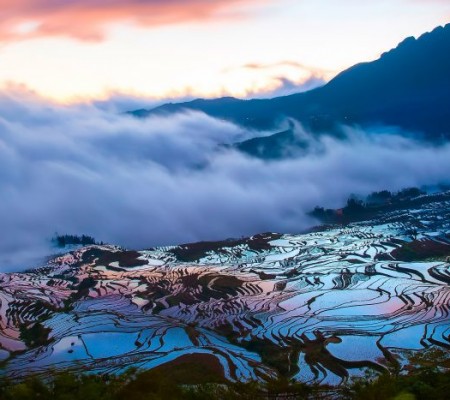
Baishuitai Culture in Shangri-La, Diqing
The breathtaking Baishuitai terraces represent both natural wonder and spiritual birthplace. Situated in Baidi Village (白地村), Shangri-La County (香格里拉县), this three-square-kilometer sinter terrace formation – China’s largest – was created by calcium carbonate deposits from mountain springs. The Naxi (纳西族) call it “growing flower,” where crystal waters cascade down Haba Snow Mountain (哈巴雪山), forming what locals reverently call “a field left by fairies.”
Birthplace of Dongba Religion (东巴教)
This sacred site witnessed the dawn of Naxi civilization:
- First Saint Dingbashiluo (丁巴什罗): The religion’s founder abandoned his Tibetan return journey upon seeing Baishuitai’s beauty, establishing his missionary base here
- Second Saint Ahmingshiluo (阿明什罗): Systematized Dongba pictographs and scriptures at this holy ground
- Doctrinal Significance: White sinter symbolizes purity in Dongba theology, making pilgrimage essential for true believers
Living Cultural Traditions
Each lunar February 8th, Naxi people celebrate their most vibrant festival:
- Wearing ceremonial attire, they circle the terraces singing and dancing
- Perform sacred rituals honoring the land’s divine creation myth
- Commemorate their transition from nomadic to agricultural life
Geological Marvel
The terraces demonstrate nature’s artistry:
- Spring water from Haba Snow Mountain deposits crystallized sodium carbonate
- Forms intricate marble-like formations across three terraced levels
- Creates stunning white mineral contrasts against emerald mountains
Spiritual Legacy
Baishuitai remains central to Naxi identity as:
- The holy land where Dongba scriptures were perfected
- A living model of the Creator’s agricultural design
- The physical manifestation of their spiritual connection to nature
This UNESCO-recognized site continues to inspire awe as both geological phenomenon and cultural touchstone, where every ripple in the sinter tells the story of a civilization’s dawn.

 7 Days GolfingTour
7 Days GolfingTour
 8 Days Group Tour
8 Days Group Tour
 8 Days Yunnan Tour
8 Days Yunnan Tour
 7 Days Shangri La Hiking
7 Days Shangri La Hiking
 11 Days Yunnan Tour
11 Days Yunnan Tour
 6 Days Yuanyang Terraces
6 Days Yuanyang Terraces
 11 Days Yunnan Tour
11 Days Yunnan Tour
 8 Days South Yunnan
8 Days South Yunnan
 7 Days Tea Tour
7 Days Tea Tour
 8 Days Muslim Tour
8 Days Muslim Tour
 12 Days Self-Driving
12 Days Self-Driving
 4 Days Haba Climbing
4 Days Haba Climbing
 Tiger Leaping Gorge
Tiger Leaping Gorge
 Stone Forest
Stone Forest
 Yunnan-Tibet
Yunnan-Tibet
 Hani Rice Terraces
Hani Rice Terraces
 Kunming
Kunming
 Lijiang
Lijiang
 Shangri-la
Shangri-la
 Dali
Dali
 XishuangBanna
XishuangBanna
 Honghe
Honghe
 Kunming
Kunming
 Lijiang
Lijiang
 Shangri-la
Shangri-la
 Yuanyang Rice Terraces
Yuanyang Rice Terraces
 Nujiang
Nujiang
 XishuangBanna
XishuangBanna
 Spring City Golf
Spring City Golf
 Snow Mountain Golf
Snow Mountain Golf
 Stone Mountain Golf
Stone Mountain Golf




